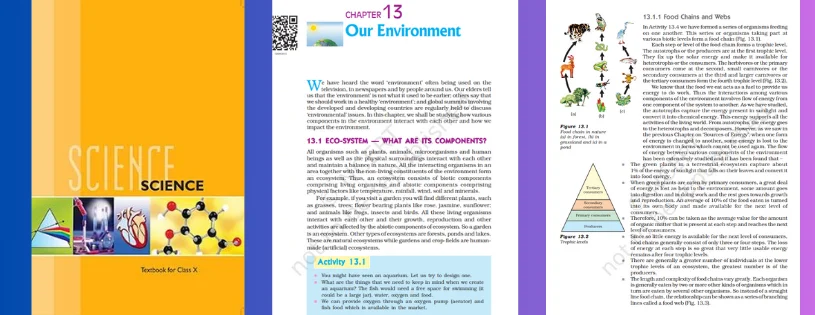The term "Our Environment" encompasses the complex and interconnected web of living and nonliving components that surround us on Earth. It is the collective sum of ecosystems, landscapes, and elements that together form the backdrop for life and shape the conditions under which living organisms thrive. Understanding and caring for our environment are crucial for the well-being of both the natural world and human societies.
Nurturing Nature: Exploring the Depths of Our Environment for a Sustainable Tomorrow
Our environment is a shared heritage that demands responsible stewardship. By fostering an understanding of its complexity and embracing sustainable practices, we can work towards a harmonious coexistence with the natural world. Preserving and protecting our environment is not just an ecological imperative but a commitment to ensuring a healthy and vibrant planet for current and future generations.
What is the Environment?
The term "environment" refers to the surroundings or conditions in which an organism, individual, or community exists. It encompasses both living (biotic) and non-living (abiotic) components that interact within a specific space and time. The environment plays a crucial role in shaping the characteristics and behaviours of living organisms and influencing various ecological processes.
Here are key components of the environment:
Biotic Factors:
-
These are the living components of the environment, including plants, animals, microorganisms, and other living organisms. Biotic factors interact with each other, forming ecological relationships and ecosystems.
Abiotic Factors:
-
These are the non-living components of the environment, such as air, water, soil, sunlight, temperature, and physical features like mountains and rocks. Abiotic factors provide the physical and chemical conditions that influence the distribution and behaviour of living organisms.
Ecosystem:
-
An ecosystem is a dynamic and interacting system of living organisms and their environment. It includes both biotic and abiotic components and involves energy flow and nutrient cycling.
Habitat:
-
A habitat is a specific place or type of environment where a particular species of organism lives. It provides the necessary conditions for the survival and reproduction of the organism.
Ecology:
-
Ecology is the scientific study of the relationships between living organisms and their environment. It explores how organisms interact with each other and with their abiotic surroundings.
Environmental Factors:
-
These are various elements that influence the well-being of organisms, such as climate, pollution levels, availability of resources, and other external conditions.
Human Impact:
-
Human activities, such as industrialization, deforestation, pollution, and urbanisation, can significantly impact the environment, leading to changes in ecosystems, climate, and biodiversity.
Sustainability:
-
The concept of sustainability focuses on maintaining the balance and health of the environment for the present and future generations. It involves responsible resource use and conservation efforts to minimise negative impacts.

CBSE Class 10 NCERT Science Topics for a Strong Foundation (NCERT DOWNLOAD)
|
CHAPTER NAME |
Our Environment |
|
Topic Number |
Topics |
|
13.1 |
Eco System |
|
13.2 |
Environmental Problems |
|
13.3 |
Ozone Depletion |
|
13.4 |
Waste production and Their Solution |
|
13.5 |
Biodegradable and Non-biodegradable Substances |
Types of Ecosystem
Ecosystems are diverse and can be found in various environments around the world. They are characterised by the interactions between living organisms and their physical surroundings. Here are some major types of ecosystems:
Terrestrial Ecosystems:
-
Forest Ecosystems:
-
Description: Dominated by trees and other woody vegetation.
-
Examples: Tropical rainforests, temperate forests, boreal forests.
-
-
Grassland Ecosystems:
-
Description: Characterised by grasses and herbaceous plants.
-
Examples: Savannas, prairies, steppes.
-
-
Desert Ecosystems:
-
Description: Arid regions with low precipitation.
-
Examples: Hot deserts, cold deserts.
-
Aquatic Ecosystems:
-
Marine Ecosystems:
-
Description: Saltwater environments covering the majority of Earth's surface.
-
Examples: Oceans, seas, coral reefs.
-
-
Freshwater Ecosystems:
-
Description: Includes rivers, lakes, ponds, and freshwater wetlands.
-
Examples: Rivers, lakes, ponds, wetlands.
-
Tundra Ecosystem:
-
Description: Cold and treeless biome with a short growing season.
-
Examples: Arctic tundra, alpine tundra.
Mountain Ecosystem:
-
Description: High-altitude regions with unique flora and fauna.
-
Examples: Himalayan Mountains, Rocky Mountains.
Urban Ecosystem:
-
Description: Human-made environments with a mix of built structures and green spaces.
-
Examples: Cities, towns.
Agricultural Ecosystem:
-
Description: Managed areas for crop cultivation and livestock farming.
-
Examples: Farmland, agricultural fields.
Polar Ecosystem:
-
Description: Extreme cold environments near the Earth's poles.
-
Examples: Arctic Circle, Antarctica.
Rainforest Ecosystem:
-
Description: Dense and diverse forests with high annual precipitation.
-
Examples: Amazon rainforest, Congo Basin rainforest.
Desert Scrub Ecosystem:
-
Description: Arid regions with scattered vegetation adapted to dry conditions.
-
Examples: Chaparral, Mediterranean scrub.
Wetland Ecosystem:
-
Description: Areas with saturated or shallow water and unique plant and animal life.
-
Examples: Marshes, swamps, bogs.
Island Ecosystem:
-
Description: Isolated land masses with distinctive flora and fauna.
-
Examples: Galápagos Islands, Hawaiian Islands.
Cave Ecosystem:
-
Description: Underground environments with specialised organisms adapted to darkness.
-
Examples: Caves, caverns.
Importance of Environment
The environment is of paramount importance as it plays a crucial role in sustaining life on Earth and maintaining the delicate balance of ecosystems. The significance of the environment extends across various dimensions, encompassing ecological, economic, social, and health aspects. Here are some key points highlighting the importance of the environment:
Biodiversity Preservation:
-
The environment is home to a vast array of species, contributing to biodiversity. Biodiversity is essential for ecosystem stability, resilience, and adaptability. It provides a source of genetic diversity, which is crucial for the survival and evolution of species.
Ecosystem Services:
-
Ecosystems provide essential services, including clean air and water, pollination of crops, decomposition of waste, and regulation of climate. These services are vital for human well-being and the functioning of global ecosystems.
Climate Regulation:
-
The environment plays a crucial role in regulating the Earth's climate. Forests, oceans, and other natural systems absorb and store carbon dioxide, helping to mitigate the impact of climate change.
Resource Availability:
-
Natural resources such as air, water, soil, minerals, and biodiversity are fundamental for human survival and economic activities. The environment serves as a source of raw materials and sustains various industries and agricultural practices.
Cultural and Recreational Value:
-
The environment contributes to the cultural identity of communities and nations. Natural landscapes, wildlife, and ecosystems hold aesthetic and recreational value, providing opportunities for leisure, tourism, and cultural practices.
Health and Well-being:
-
Clean air, water, and a healthy environment are essential for human health. A degraded environment can lead to pollution, the spread of diseases, and other health hazards. Access to green spaces also contributes to mental well-being.
Economic Stability:
-
Many economic activities, such as agriculture, forestry, fisheries, and tourism, depend on a healthy environment. Environmental degradation can lead to economic losses and disruptions in various industries.
Water Management:
-
The environment is a critical component of the water cycle, influencing precipitation, groundwater recharge, and water quality. Healthy ecosystems contribute to reliable and sustainable water resources.
Soil Fertility and Agriculture:
-
Healthy soils, supported by diverse ecosystems, are crucial for agriculture. Ecosystems contribute to soil fertility, nutrient cycling, and pest control, enhancing the productivity of agricultural lands.
Global Interconnectedness:
-
The environment connects people and nations globally. Changes in one part of the world can have far-reaching impacts on ecosystems, climate, and biodiversity across the planet. International cooperation is essential for addressing global environmental challenges.
Impact of Human Activities on the Environment
Human activities have had profound and often detrimental impacts on the environment, leading to a range of ecological, social, and economic challenges. The scale and intensity of these impacts have increased significantly with population growth, industrialization, and technological advancements. Some key impacts of human activities on the environment include:
Deforestation:
Impact: Clearing of forests for agriculture, logging, and urbanisation.
Consequences: Loss of biodiversity, disruption of ecosystems, release of stored carbon, and changes in local and global climates.
Air Pollution:
Impact: Emission of pollutants from industrial processes, transportation, and burning of fossil fuels.
Consequences: Degraded air quality, respiratory diseases, climate change, and damage to ecosystems.
Water Pollution:
Impact: Discharge of pollutants into rivers, lakes, and oceans from industrial effluents, agriculture, and urban runoff.
Consequences: Contamination of water sources, loss of aquatic biodiversity, and threats to human health.
Climate Change:
Impact: Greenhouse gas emissions (e.g., carbon dioxide) from burning fossil fuels, deforestation, and industrial activities.
Consequences: Global warming, rising sea levels, extreme weather events, and disruptions to ecosystems.
Loss of Biodiversity:
Impact: Habitat destruction, overexploitation of species, pollution, and climate change.
Consequences: Extinction of species, reduced ecosystem resilience, and potential loss of ecosystem services.
Land Degradation:
Impact: Unsustainable agricultural practices, deforestation, and urbanisation.
Consequences: Soil erosion, loss of arable land, reduced agricultural productivity, and desertification.
Overexploitation of Natural Resources:
Impact: Unsustainable extraction of resources such as fish, minerals, and forests.
Consequences: Depletion of resources, loss of biodiversity, and socioeconomic challenges for communities dependent on these resources.
Waste Generation:
Impact: Improper disposal of solid and hazardous waste.
Consequences: Pollution of land, air, and water, harm to wildlife, and risks to human health.
Urbanisation and Infrastructure Development:
Impact: Expansion of cities, construction of roads, and infrastructure projects.
Consequences: Habitat loss, fragmentation of ecosystems, and altered water and nutrient cycles.
Noise Pollution:
Impact: Noise from urban areas, transportation, and industrial activities.
Consequences: Stress on wildlife, disruption of animal communication, and adverse effects on human health.
CBSE Class 10 Board Exam Sample Paper
|
|
|
Chapter1: Chemical Reactions and Equations |
|
Chapter2: Acids, Bases and Salts |
|
Chapter3: Metals and Non-metals |
|
Chapter4: Carbon and its Compounds |
|
Chapter5: Life Processes |
|
Chapter6: Control and Coordination |
|
Chapter7: How do Organisms Reproduce? |
|
Chapter8: Heredity |
|
Chapter9: Light – Reflection and Refraction |
|
Chapter10: The Human Eye and the Colourful World |
|
Chapter11: Electricity |
|
Chapter12: Magnetic Effects of Electric Current |
|
Chapter13: Our Environment |
|
|
|
Class 8 |
|
Class 9 |
|
Class 11 |
|
Class 12 |
CBSE Class 10th Downloadable Resources:
|
1. CBSE Class 10th Topic Wise Summary |
|
|
2. CBSE Class 10th NCERT Books |
|
|
3. CBSE Class 10th NCERT Solutions |
|
|
4. CBSE Class 10th Exemplar |
|
|
5. CBSE Class 10th Previous Year Papers |
|
|
6. CBSE Class 10th Sample Papers |
|
|
7. CBSE Class 10th Question Bank |
|
|
8. CBSE Class 10th Topic Wise Revision Notes |
|
|
9. CBSE Class 10th Last Minutes Preparation Resources (LMP) |
|
|
10. CBSE Class 10th Best Reference Books |
|
|
11. CBSE Class 10th Formula Booklet |
Being in CBSE class 10th and considering the board examinations you must be needing resources to excel in your examinations. At TestprepKart we take great pride in providing CBSE class 10th all study resources in downloadable form for you to keep you going.
Below is the list of all CBSE class 10th Downloads available on TestprepKart for both Indian and NRI students preparing for CBSE class 10th in UAE, Oman, Qatar, Kuwait & Bahrain.
FAQ
Q1: What is meant by "Our Environment"?
A: "Our Environment" refers to the surroundings in which we live, encompassing the physical, biological, and human elements that make up the Earth's ecosystems.
Q2: What are the key components of the environment?
A: The environment includes both living (biotic) and non-living (abiotic) components. Biotic components are living organisms, while abiotic components include air, water, soil, sunlight, and physical features.
Q3: Why is biodiversity important for our environment?
A: Biodiversity enhances ecosystem stability, resilience, and adaptability. It contributes to ecosystem services, such as pollination, water purification, and climate regulation.
Q4: How do human activities impact our environment?
A: Human activities, such as deforestation, pollution, and overexploitation of resources, have significant negative impacts on the environment, leading to biodiversity loss, climate change, and degradation of ecosystems.
Q5: What are the consequences of air and water pollution on our environment?
A: Air and water pollution can lead to health issues, damage ecosystems, and contribute to climate change. Contaminated air and water affect the well-being of both humans and wildlife.


Leave a Reply